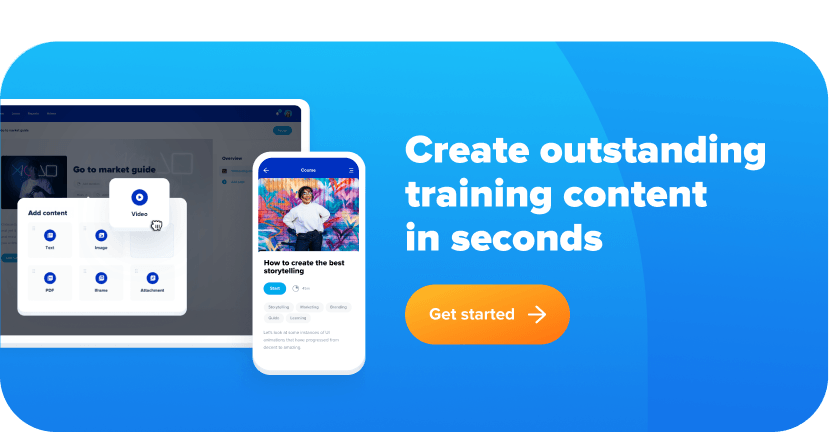This means your instructional design strategies are increasingly important if you want to create courses that capture attention, facilitate learning, and bring employees the confidence they need to succeed in their role.
In this article, we’ll take a look at the fundamentals of instructional design for elearning courses to explore how you can make your digital training effective and engaging, plus the core principles and strategies that can transform the way you think about digital education.
Understanding instructional design for elearning
What is instructional design for elearning?
To put it simply, instructional design for elearning is a systematic approach to developing digital courses that deliver knowledge and skills effectively. It combines educational theory, technology, and creativity to create structured learning experiences tailored to specific learner needs. It’s an approach that’s crucial for making online education accessible, engaging, and impactful.
The role of instructional design in elearning courses
Instructional design plays a pivotal role in aligning course content with learning objectives, ensuring that every module and activity serves a clear purpose.
When courses are thoughtfully designed, learners are more likely to stay engaged and retain information. Effective instructional design strategies enhance user experience, reduce cognitive overload, and create a seamless learning journey that meets educational goals.

Key principles of instructional design for elearning courses
The ADDIE model (Analyze, Design, Develop, Implement, Evaluate) provides a robust framework for instructional design. Here’s a quick run through:
1. Analyzing learner needs
Understanding the target audience is the first step in successful instructional design. This involves identifying learner profiles, assessing their knowledge gaps, and defining the specific outcomes the course should achieve. A thorough analysis lays the groundwork for creating personalized learning experiences that address real needs and drive meaningful engagement.
2. Designing learner-centered content
The design phase transforms insights from the analysis into a structured plan for the course. This involves crafting content that captures interest and reinforces key concepts through interactive elements like quizzes, scenarios, and simulations. Breaking material into manageable sections keeps learners focused, while clear objectives guide the creation of an engaging and purposeful learning experience.
3. Developing effective course materials
In the development phase, the design plan takes shape. Instructional designers collaborate with subject matter experts and developers to create high-quality content, integrating multimedia elements like videos and animations to enhance the learning experience. Rigorous testing and refinement ensure the final materials are polished and ready for implementation.
4. Implementing courses for maximum impact
During implementation, the course is delivered to learners. Effective implementation involves ensuring technical functionality and providing support to learners as they engage with the content. This phase bridges the design and learner experience, ensuring that courses are accessible and intuitive to use.
5. Evaluating and improving courses
Evaluation is key to maintaining the effectiveness of elearning courses. Feedback from learners, combined with analytics on engagement and performance, provides actionable insights for improvement. Regular updates based on this data ensure courses remain relevant, impactful, and aligned with evolving educational needs.
Instructional design strategies for elearning
Using storytelling to boost learner engagement
Storytelling is a powerful tool for enhancing understanding and retention. By embedding relatable scenarios into elearning content, learners can connect with the material on a personal level. For example, a compliance training module might feature a story about an employee navigating ethical dilemmas, making abstract concepts more tangible and memorable.
Gamification in elearning courses
Gamification transforms learning into an interactive and enjoyable experience. By integrating elements like leaderboards, badges, and challenges, instructional designers can motivate learners to participate actively and achieve their goals. For instance, sales training might include a leaderboard that ranks participants based on their progress, fostering a sense of competition and achievement.
Creating mobile-friendly elearning content
In an increasingly mobile world, accessibility is critical. Instructional design strategies for elearning emphasize creating responsive content that works seamlessly on various devices. This includes optimizing navigation, ensuring media compatibility, and designing intuitive interfaces that enhance usability.
Best practices for instructional design for elearning courses
Designing for accessibility and inclusion
Inclusive design ensures that elearning courses meet the needs of all learners, including those with disabilities. This involves incorporating features like captions for videos, screen reader compatibility, and adjustable font sizes. By prioritizing accessibility, instructional designers create equitable learning opportunities for everyone.
Balancing aesthetics with functionality
While visuals enhance the learning experience, they should never overwhelm the content. Effective instructional design balances aesthetics with functionality, using clean layouts, professional imagery, and purposeful design elements that guide learners without distracting them.

How to measure the effectiveness of elearning courses
Measuring the success of elearning courses involves tracking learner performance through assessments, completion rates, and analytics provided by the LMS. These metrics help identify areas for improvement and ensure that courses continue to meet learning objectives. By analyzing data on learner engagement and outcomes, instructional designers can refine their strategies and deliver even greater value.
Find the right LMS to support your instructional design
Instructional design for elearning is essential for creating courses that are engaging, effective, and learner-centered. By applying principles such as analyzing needs, designing interactive content, and implementing evaluation mechanisms, instructional designers can transform online education into a meaningful and impactful experience.
Whether through storytelling, gamification, or mobile-friendly design, the strategies we’ve looked at provide a roadmap for success. Embracing these techniques will help educators and organizations create elearning courses that not only educate but inspire.
Contact eloomi and book an LMS demo and learn how you can easily create, manage, deliver and track your elearning content.

/





